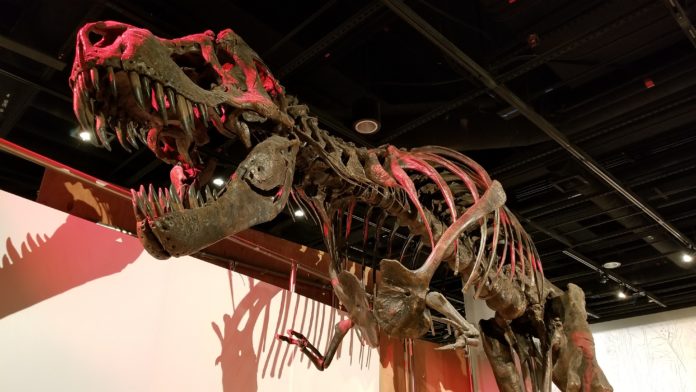Tyrannosaurids — the family of dinosaurs that includes Tyrannosaurus rex — have long been known to be among the largest predators to ever walk the Earth.
Now, thanks to a newly-discovered set of baby tyrannosaurid bones, a team of scientists from the University of Alberta can also say that these fearsome predators were among the largest animals to ever hatch from an egg.
The study was led by Gregory Funston, a Canadian palaeontologist and postdoctoral researcher at the University of Edinburgh, and published in the Canadian Journal of Earth Sciences.
“Among the largest babies to ever emerge from eggs”
Thanks to a particularly good fossil record, palaeontologists have been able to learn a great deal about tyrannosaurids. The anatomy, diversity, and evolution of these meat-eating dinosaurs has been thoroughly studied and documented since the initial discovery of tyrannosaurids in the early 1900s, and has likely contributed to the popularity of T. rex and other tyrannosaurids in popular culture.
Despite this, relatively little is known about tyrannosaurid growth and reproduction. While eggs from other dinosaur species have been found and studied in great detail, palaeontologists have been unable to find fossilized remains of tyrannosaurid eggs or embryos — and until now, this led many to believe that tyrannosaurids may not have nested in the same locations as other dinosaurs present at the time.
But with the help of two newly-discovered baby tyrannosaurid bones — a foot claw and a lower jaw — Funston and his colleagues have finally begun to piece together these gaps in our knowledge. The embryonic bones were discovered on Indigenous land in Alberta and Montana, and provide palaeontologists with the first clues as to what tyrannosaurid offspring were really like.
“We were immediately surprised by how much the bones looked like those of adult tyrannosaurs,” Funston said in a blog post. “Even though this specimen is 20% the size of the next smallest tyrannosaur jaw, they’re remarkably similar in their proportions and features.”
The team was able to study the bones in greater detail with the help of high-powered x-rays from a particle accelerator, which allowed the researchers to create a three-dimensional, virtual reconstruction of the bones.
The fossils themselves are extremely fragile, and this 3D reconstruction helped the researchers study the bones without having to worry about damaging them. In fact, in the case of the tyrannosaurid jawbone studied by Funston and his colleagues, the specimen itself was actually embedded inside a piece of rock and couldn’t be removed without destroying the fossil in the process.
3D reconstruction techniques also allow scientists to look inside fossils without breaking them apart. And for fossils that have been flattened or distorted by the build-up of sediments on top of the specimen, 3D reconstructions can help palaeontologists better understand what the specimen would have realistically looked like when alive.
Using this 3D scanning technique, Funston and his colleagues discovered that the tyrannosaurids were roughly a metre long upon hatching, which means that their eggs would have been about 17 inches long.
“[T]his ranks tyrannosaur hatchlings as among the largest babies to ever emerge from eggs on land,” said Funston.
The hunt for tyrannosaurid nests is on
While Funston’s research answers many questions about tyrannosaurid offspring, a number of new questions have emerged.
In particular, researchers are now wondering why embryonic tyrannosaurids took so long to find in the first place. The bones were found in well-known dinosaur nesting sites, which means that while palaeontologists have been looking in the right places, something has prevented them from uncovering tyrannosaurid eggs.
“One idea we speculate upon in our paper is that tyrannosaurs could have laid soft-shelled eggs like their ancestors,” Funston said, “but this is just a guess, and it would have to go against conventional wisdom.”
Whatever the reason may be, these new results will certainly help guide future searches for tyrannosaurid eggs and embryos. Researchers now have a better idea of what they’re looking for, and can use this knowledge to inform future searches.
“We’re definitely going to continue our fieldwork in both localities,” said Funston, “and hope that our efforts turn up more baby tyrannosaur bones!”









































